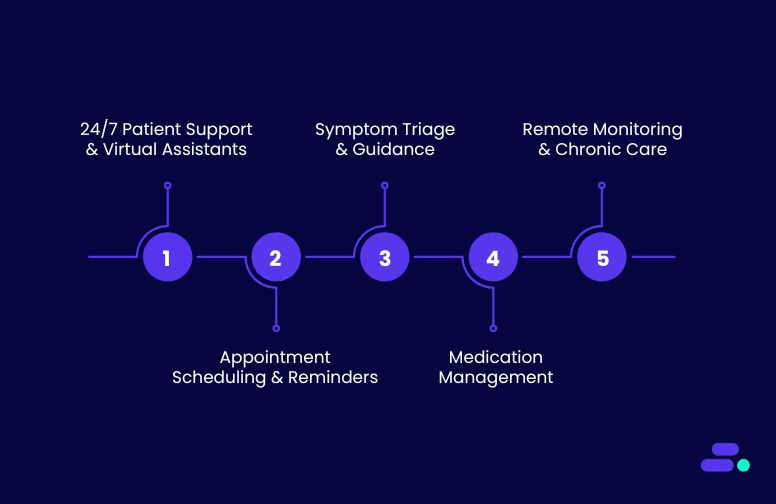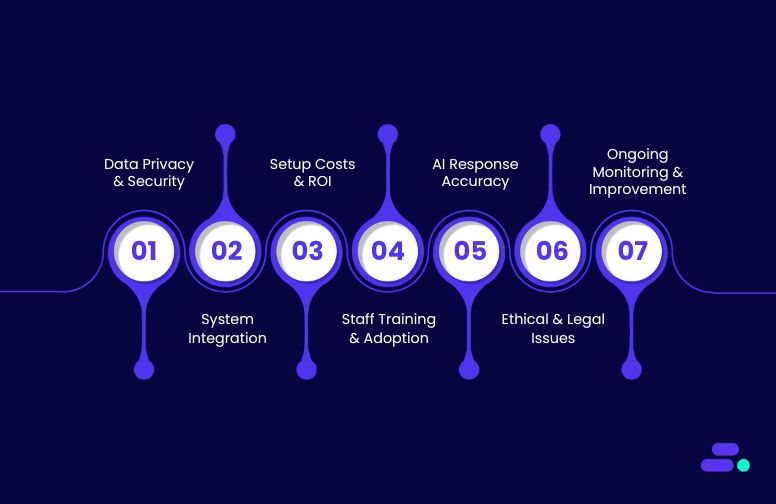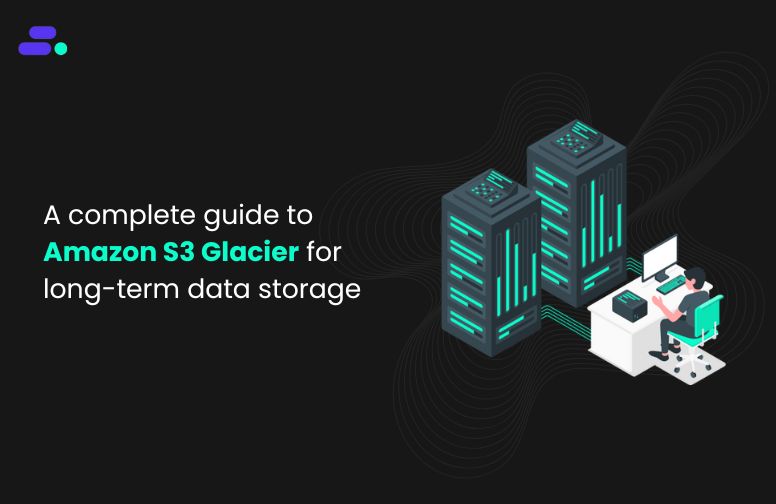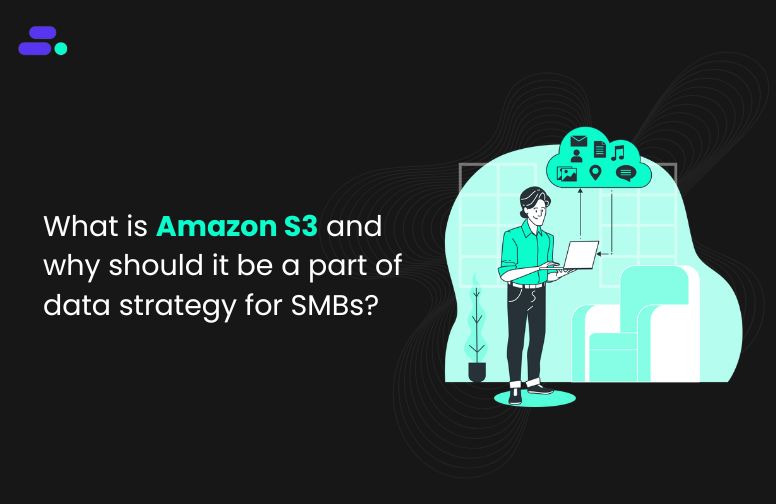This is a div block with a Webflow interaction that will be triggered when the heading is in the view.

Modernize your cloud. Maximize business impact.
Backend automation mostly starts with quick fixes using cron jobs, custom scripts, or ad-hoc code. But as systems grow, these solutions become brittle, hard to debug, and tough to scale.
Consider a patient intake process, which includes verifying insurance, updating EHRs, and notifying staff. With cron jobs or custom code, failures might go unnoticed until they impact care. Serverless Step Functions offer a better path with automated, scalable workflows that handle errors, retries, and dependencies without constant oversight.
SMBs can design these processes as visual, reliable workflows, fully managed, event-driven, and scalable by default. No more maintaining background scripts or worrying about what happens if a step fails at 3 AM.
This article explores why SMBs are making the shift from legacy automation methods to serverless step functions, and how this move is helping them streamline operations.
Key takeaways:
- AWS Step Functions simplify workflow automation by coordinating tasks like validation, API calls, and notifications without managing servers.
- Built-in error handling and retries ensure processes run reliably, reducing manual rework and system downtime.
- Parallel execution boosts efficiency, allowing multiple tasks (like scheduling and notifications) to run simultaneously.
- AWS Step Functions scales automatically, making it ideal for SMBs looking to grow without adding operational overhead.
- Working with an AWS Partner like Cloudtech accelerates implementation and ensures automation aligns with real SMB goals.
The hidden costs of cron jobs and custom glue code
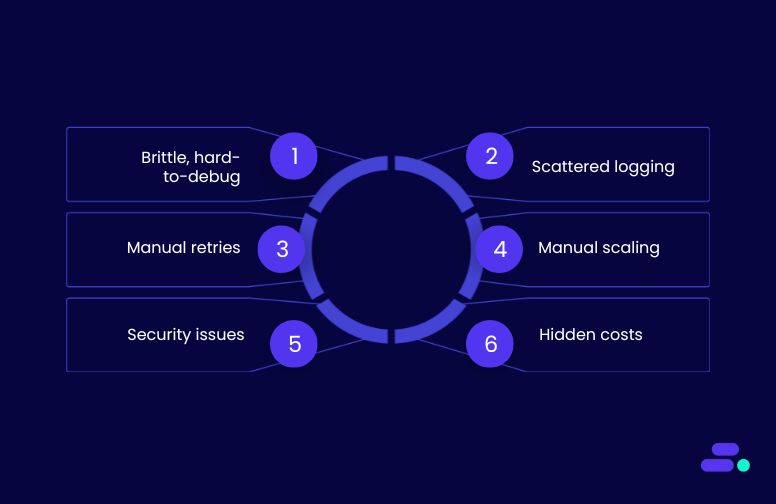
At first, cron jobs and glue code feel like quick wins. They’re simple, familiar, and seem to get the job done. But over time, what starts as a straightforward script might turn into a fragile patchwork that introduces more problems than it solves, especially for growing businesses operating in the cloud.
The operational pain points behind the scenes:
- Brittle and hard to debug: Cron jobs lack built-in error handling or visibility. If a task fails silently at 2 a.m., teams may not know until users complain, or worse, sensitive workflows go incomplete.
- Scattered logging and monitoring: Logs are often stored across different systems (or nowhere at all), making it hard to trace issues or maintain compliance. Debugging becomes time-consuming and frustrating.
- Manual retries and failure recovery: When a job fails, someone has to step in and manually re-trigger it or fix the data it left half-processed. This reactive approach slows teams down and increases risk.
- Scaling is manual or non-existent: Most cron jobs run on fixed infrastructure. As load increases, performance suffers, or teams need to intervene to scale manually, neither of which supports agility.
- Security and access management headaches: Scripts and jobs often use hardcoded credentials or shared environments, creating security gaps that are difficult to audit or manage.
- Hidden maintenance costs: Over time, teams spend more effort maintaining brittle code than delivering new features. And when the person who wrote the job leaves, knowledge often walks out the door too.
Why this doesn’t scale in the cloud: Modern cloud-native environments thrive on automation, observability, and scalability. Cron jobs and glue code weren’t designed for this. They may seem like the fastest route early on, but they’re rarely the most sustainable or cost-effective as the business grows.
That’s why SMBs are shifting toward orchestrated, serverless solutions like AWS Step Functions. They offer a structured, fault-tolerant way to automate complex workflows, with less operational baggage.

How do AWS Step Functions deliver scalable, reliable, and maintainable workflows?
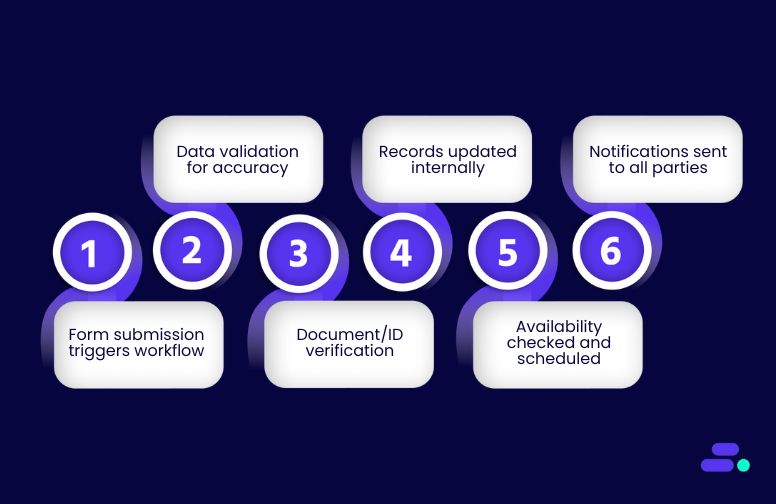
As SMBs grow, so do the demands on their backend systems. What once worked with a few cron jobs or scripts often becomes a tangled web of logic. For lean teams, especially in regulated industries, even a minor workflow failure can lead to compliance risks, lost productivity, or customer frustration.
To better understand the relevance of serverless step functions over cron jobs and custom code, take the example of a growing healthcare clinic. Onboarding a new patient involves several steps, many of which were traditionally manual or loosely automated. With AWS Step Functions, that is no longer the case:
Step 1: Intake form submission triggers the workflow
The patient intake journey begins the moment someone fills out an online form, maybe on a clinic’s website or patient portal. Traditionally, this would require backend polling, manual data entry, or cron-based checks to process form submissions. With AWS Step Functions, the process becomes instant, event-driven, and serverless.
Here’s how it works behind the scenes:
- Amazon API Gateway receives the HTTP POST request from the form and acts as the front-door to the workflow, providing a secure and scalable entry point.
- AWS Lambda processes the incoming request, sanitizes data if needed, and then directly starts the Step Function execution using the AWS SDK.
- AWS Step Functions picks up the baton immediately, no need for persistent infrastructure or background schedulers to monitor form submissions.
Outcome: The moment a patient submits the form, the automation begins in real time. This ensures no delays, removes the need for backend polling scripts, and guarantees that no intake request falls through the cracks, even during peak load. It's fast, secure, and fully managed from the first click.
Step 2: Validate patient data
After intake submission, the next critical step is validating patient information. This includes ensuring required fields are present, checking for formatting errors, and verifying identifiers like insurance numbers. In many SMB healthcare setups, this would typically involve handwritten scripts or manual admin review, both prone to error and delay. With AWS Step Functions, validation becomes automated, consistent, and fault-tolerant.
Here’s how AWS handles this step:
- AWS Lambda handles validation logic, such as checking for missing fields, malformed contact details, or mismatched insurance number formats.
- AWS Step Functions' built-in error handling automatically catches failures and retries based on a configurable policy, no need for custom retry logic or manual intervention.
- ResultPath and Catch blocks in AWS Step Functions allow seamless branching, sending invalid entries to a remediation workflow or alert queue without breaking the entire process.
Outcome: Patient data is reviewed and validated in real time, with failed attempts retried automatically and consistently. This reduces human error, saves staff time, and ensures that only clean, verified data moves forward, essential for compliance, billing, and patient safety.
Step 3: Document verification
Once patient data is validated, the next step is verifying supporting documents such as ID proof, insurance cards, or medical history forms. In traditional SMB environments, this often involves email attachments, manual uploads, or local storage, all of which are error-prone and hard to scale. With AWS, this entire step becomes automated and intelligent.
Here’s how AWS handles this step:
- Amazon S3 securely stores uploaded documents, providing durable, scalable storage that integrates easily with downstream services.
- AWS Lambda picks up the file event and invokes Amazon Textract, which automatically extracts key identity data (e.g., name, date of birth, insurance details) using AI-powered OCR.
- AWS Step Functions monitors the output from Textract. If the document is unreadable or incomplete, it routes the case to a manual review queue (e.g., via Amazon SQS or a custom admin dashboard), ensuring the rest of the workflow continues unaffected.
Outcome: SMBs can automate identity verification without compromising on accuracy or compliance. The system intelligently handles bad scans or missing info without disrupting the broader process, freeing up staff to focus only on exceptions while scaling smoothly during high patient volumes.

CTA Button Link:
Step 4: Patient record update in EHR
After verifying documents, the final step in onboarding is updating the patient’s information in the clinic’s Electronic Health Record (EHR) system. Traditionally, this might involve a staff member manually entering data into multiple systems, which is a time-consuming and error-prone process. With Step Functions, this step is programmatically automated and resilient to failure.
Here’s how AWS handles this step:
- AWS Lambda packages the verified patient data and makes a secure API call to the external EHR system. This could be a RESTful endpoint exposed by a third-party provider.
- AWS Step Functions defines retry logic using exponential backoff and timeout policies. If the EHR system is temporarily down or responds with an error, the function automatically retries without manual intervention.
- Failure handling is built in. If all retries fail, the Step Function can trigger an alert (e.g., via Amazon SNS) or route the request to a dead-letter queue for follow-up.
Outcome: The patient record is updated in real time, reliably and securely. Even if the external system is intermittently unavailable, the workflow stays resilient, reducing admin effort, preventing data loss, and ensuring compliance with healthcare data handling requirements.
Step 5: Check appointment availability and schedule
Once patient records are updated, the next step is to schedule their appointment, often a bottleneck when done manually or handled sequentially in code. With AWS Step Functions, this part of the workflow can be both parallelized and automated, improving speed and patient experience.
Here’s how AWS handles this step:
- AWS Lambda invokes the appointment scheduling microservice (or API) to check for available time slots based on doctor schedules, patient preferences, or clinic hours.
- AWS Step Functions' Parallel State enables this to run alongside other actions like sending a confirmation email or updating the CRM without waiting for one to finish before the other starts.
- Conditional branching can be added if no slots are available. For e.g., prompt the patient to choose another time or notify staff for follow-up.
Outcome: The system instantly finds a matching slot and confirms the appointment, while other tasks (like sending notifications) continue in parallel. This reduces patient wait times, eliminates scheduling delays, and enables the clinic to operate more efficiently even during peak hours.
Step 6: Notify patient and staff
Once the appointment is locked in, timely communication is critical, not just for patient experience, but also for operational coordination. Instead of relying on separate tools or manual follow-ups, AWS Step Functions lets users automate this step with full traceability.
Here’s how AWS handles this step:
- AWS Lambda sends a confirmation email to the patient using a service like Amazon SES or a third-party provider integrated via API.
- Amazon SNS (Simple Notification Service) is optionally triggered to send an SMS alert, either to the patient, front-desk staff, or both.
- AWS Step Function execution history captures every notification attempt, making it easy to audit or troubleshoot if a message fails to send.
Outcome: Every stakeholder receives timely updates, and the entire process is visible in one place. No more guesswork, missed messages, or siloed systems. Notifications are consistent, auditable, and automated, ensuring patients feel cared for and staff stay informed.
Do these benefits apply for SMBs in other sectors?
While the above use case followed a healthcare clinic automating patient intake and scheduling, the same workflow structure applies to SMBs across industries. Whether it’s a logistics firm automating shipment tracking, a financial services company validating KYC documents, or an e-commerce business handling returns, the building blocks remain the same:
- An event (form submission, file upload, payment, etc.) triggers a Step Function using API Gateway and Lambda.
- The workflow automatically coordinates the required steps, from validation to external API calls to notifications.
- Tasks run in parallel where possible, and errors are handled without human intervention.
The real power lies in how AWS Step Functions deliver enterprise-grade orchestration with zero infrastructure burden.
For the healthcare SMB, this means no more background scripts or fragile cron jobs. For other SMBs, it means reliable, scalable, and auditable workflows without hiring an ops team. With AWS Step Functions, automation becomes a strategic asset, not a maintenance headache.

Even if SMBs are unsure of how the transition to AWS Step Functions affects their workflow, AWS partners like Cloudtech can help them with the implementation. With deep expertise in architecting serverless workflows, Cloudtech helps SMBs design and implement automation that’s reliable from day one.
Why do SMBs trust Cloudtech to implement step functions right?

Orchestrating complex workflows with AWS Step Functions isn’t just about wiring services together, it’s about designing for scalability, resilience, and long-term maintainability from day one. That’s where Cloudtech, an AWS Advanced Tier Services Partner built exclusively for SMBs, brings unique value.
As a managed cloud partner, Cloudtech helps small and mid-sized businesses go beyond automation experiments to real-world, production-ready outcomes. Here’s how:
- SMB-native support model: Lean teams get 24/7 monitoring, fast incident response, and patch management, without enterprise complexity or vendor lock-in.
- Resilience and security baked in: Every Step Function architecture includes IAM best practices, automated retries, backup strategies, and multi-AZ failover.
- Cost and performance optimization: Cloudtech continuously tunes workflows using tools like AWS CloudWatch, Trusted Advisor, and X-Ray, ensuring automation stays efficient as businesses grow.
- Guided enablement: Beyond implementation, Cloudtech helps SMBs build internal confidence, offering knowledge transfer, architectural clarity, and proactive recommendations.
With Cloudtech, SMBs gain more than a serverless workflow. They gain a strategic partner that helps turn AWS automation into a business advantage.
See how other SMBs have modernized, scaled, and thrived with Cloudtech’s support →

Wrapping up
Serverless automation with AWS Step Functions gives SMBs the ability to streamline operations, reduce errors, and scale workflows without managing infrastructure. But unlocking that value consistently requires more than tools. It takes guidance, experience, and a partner who understands the unique needs of growing businesses.
That’s where Cloudtech comes in. As an AWS Advanced Tier Partner focused solely on SMBs, Cloudtech doesn’t just deploy automation, it delivers long-term business value. With a proactive, cost-conscious approach to managed services, they help SMBs move faster, operate smarter, and avoid the common pitfalls of DIY cloud.
When operations are on autopilot, innovation can take the driver’s seat. Ready to make your workflows more resilient, and your business more agile? Get on a call and find out how Cloudtech can help you scale with confidence.
FAQs
1. Do SMBs need coding expertise to use AWS Step Functions?
Not always. While defining workflows typically involves JSON using Amazon States Language (ASL), AWS also provides a visual editor that makes it easy to view and manage workflows. With the right AWS Partner, even teams with limited coding resources can implement and operate Step Functions effectively.
2. Can Step Functions integrate with existing SMB systems?
Yes. Step Functions integrate easily with both AWS services and external systems via Lambda functions, API Gateway, and SDKs. Whether an SMB uses ERP platforms, CRMs, or industry-specific tools, workflows can be designed to automate and orchestrate across these systems seamlessly.
3. What happens if part of a workflow fails?
AWS Step Functions include built-in error handling, retries, and fallback paths. If a task fails, such as a timeout or a downstream API error, the system can automatically retry or trigger an alternate step, preventing silent failures and minimizing disruption.
4. Is this scalable as the business grows?
Absolutely. Step Functions are serverless and scale automatically with demand. Whether an SMB runs a few workflows a day or thousands, there’s no infrastructure to manage. This makes it especially well-suited for growing companies that need reliable automation without added operational complexity.
5. How does an AWS Partner like Cloudtech help?
Cloudtech helps SMBs implement Step Functions in a way that’s secure, efficient, and tailored to their unique workflows. As an AWS Advanced Tier Partner focused on SMBs, Cloudtech supports everything from initial architecture design to long-term optimization, ensuring each workflow delivers measurable business value.

Get started on your cloud modernization journey today!
Let Cloudtech build a modern AWS infrastructure that’s right for your business.

